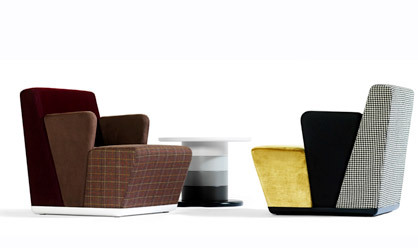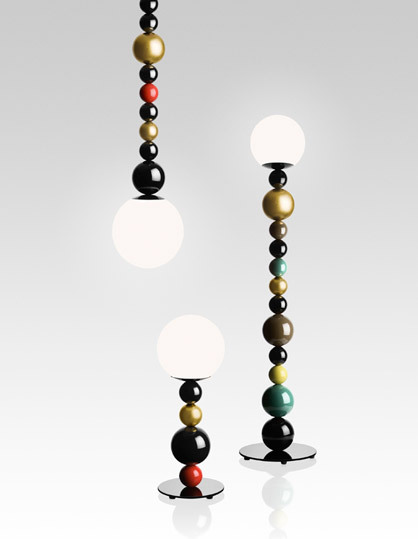More Colour!
Texte par Nora Schmidt
Berlin, Allemagne
20.02.08
A few kilometres to the north of Swedens capital Stockholm, in a picturesque house which lies on the former hunting grounds of the kings of Sweden.
A few kilometres to the north of Stockholm, in a picturesque house which lies on the former hunting grounds of the kings of Sweden – this is where Fredrik Mattson has his studio. In recent years the 34-year old furniture designer has made a name for himself on the Scandinavian design scene with his playful and colourful creations.
"A bit of colour here and there doesn't do any harm, does it?" – Fredrik Mattson is a man after my own heart.
I met him during the Stockholm furniture fair for a nice talk.
Architonic: Fredrik, what's your opinion of the fair?
Fredrik Mattson: To be honest I'm not so sure. There's so much that's new. It's unbelievable how many new products and designs are presented every year.
That sounds a little like criticism.
I don't really want to be negative. But sometimes I believe that we get too much novelty just for the sake of novelty. In order to stay in the news the manufacturers have to produce something new for every show, whether it's in Stockholm, Milan, Cologne or Tokyo. Even the biggest firms can't produce exclusively good furniture at this pace. This is also the reason why you see so much rubbish round here.
Do you as a designer have any influence on this trend?
Not really. The situation has a lot to do with the whole spirit of the times. We're simply living in an age when everything moves faster. And I too have to subject myself to this trend. But if we think back 40 years ago – don't get me wrong, I don't want to sound nostalgic, but in those days designers simply took three or four years' time to develop a piece of furniture. And even from today's perspective this furniture is still of impressive quality. Nowadays the manufacturers are under such pressure that they often don't have time to sit back and think about things.
Does this pressure have an effect on your work, too?
Definitely, and that's something no designer will be able to deny.
You're a carpenter by trade. Is it your training which has given you a special feeling for design?
I think so. As a carpenter I attach a great deal of value to finish, and such things as combining materials. What I have learned as a carpenter is to make things which will last. This is why I'm disturbed by the short-lived nature of present-day design. But I'm convinced that there will soon be a counter movement. Durability, both in the qualitative and in the aesthetic sense, will once more become an important factor.
In spite of this your work is not timeless in the sense of being simple and unadorned.
No. The products which surround us have an enormous influence on our mood. And I simply enjoy feeling good. This is what I try to convey with my design work. Take the lamps for Zero, for example. Lamps are small objects which we should really permit ourselves to make more colourful and playful. I'm fed up with these interiors in all imaginable shades of gray.
In my RGB lamp I paid a little more attention to the cable – this basic part of a lamp which creates the connection between the source of the electricity and the source of the light. As in a chain of pearls the colourful balls are strung along the cable, with the aim of giving the lamp something of the elegance of a piece of jewellery.
In your lounge chair series for Blå Station you worked with a similar colour range.
With Fellows the upholstery material plays a decisive role. With seating the individual elements generally correspond to the parts of our own bodies. There's the backrest, against which we lean as if we were leaning against the back of someone sitting next to us. The arm rests seem to be like the arms of a friend which we can take hold of and which support us.... This gives seating something of a character of its own, and this is what I wanted to highlight with Fellows.
For example you have the serious gentleman in a pinstriped suit and wearing black leather shoes. Or the stylish Coco Chanel in a sheath dress with buttons of gold. When the chairs are grouped round a table it really looks as if they are having a pleasant chat over a cup of coffee.
A really beautiful picture. The Tivoli chair, which was developed in cooperation with the Danish firm of PP Møbler, is taking a more high-tech direction.
Yes. PP are the experts when it comes to the industrial processing of wood. That's my definite opinion. We have decided to launch an experiment which will test the limits of the material. With its complex equipment PP has the possibility of giving wood enormous flexibility during processing. For this purpose the wood is clamped into a machine which then compresses it by 40 % in the direction of the grain. After that you can bend it like spaghetti. The Tivoli is an extreme example of this technique.
How long is the wound-up coil?
It consists of three sections and is about eight metres long together.
The Tivoli chair is still only a prototype. Will it be developed further?
Yes, we're working on it. The cooperation with PP will continue, and we've still got plenty of joint projects to complete.
Fredrik, many thanks for talking to us.









